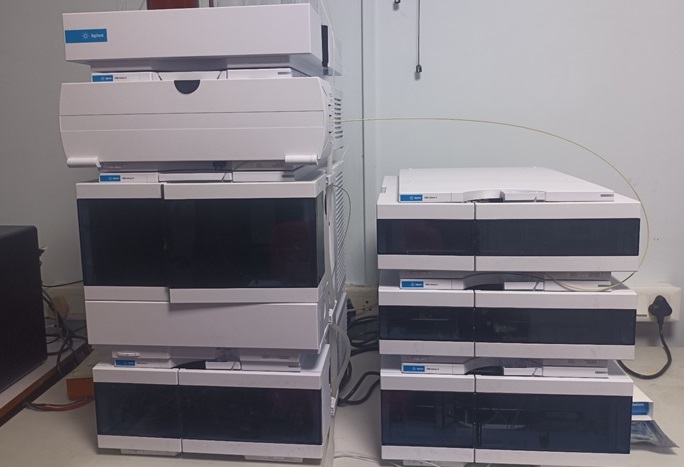- APPLY FOR SLOT
- Internal Users
- External Users
- SLOT BOOKING STATUS
High Performance Liquid Chromatography Lab (HPLC)

Phone : +91-3222-283104
Location : OB / FF / 1, CRF
Facilitator :
Prof. Rintu Banerjee, Agricultural and Food Engineering
Email: rb@agfe.iitkgp.ac.in, Contact:+91-3222-283104
For Internal Users - Click Here to apply for Slot
For External Users - Click Here to apply for Slot
Objectives
High-performance liquid chromatography or commonly known as HPLC, is an analytical technique used to separate, identify or quantify each component in a mixture.
The mixture is separated using the basic principle of column chromatography and then identified and quantified by spectroscopy. HPLC is thus basically a highly improved form of column liquid chromatography. Instead of a solvent being allowed to drip through a column under gravity, it is forced through under high pressures.
Normal Phase Chromatography
Normal phase is a specific type of partitioning chromatography where the stationary phase is polar, and the mobile phase is non-polar. While the compounds selected might not be particularly polar or non-polar, their relative polarities are the most important. As long as the stationary phase is more polar than the mobile phase, it is considered normal phase chromatography. The stationary phase is usually a column packed with silica particles that have R groups attached. Common R groups for normal phase are -C2H4CN or -C3H6NH2. When the mixture passes through the column, the polar components will be more attracted to the stationary phase and the non-polar components will be attracted to the mobile phase. This will lead the non-polar components to flow through (or elute) the column first. The more polar a compound is, the longer it will take to elute. By increasing the polarity of the mobile phase, the bound polar component will partition more into the mobile phase and elute from the column.
Reverse Phase Chromatography Reversed phase chromatography is another type of partition chromatography but is opposite from normal phase. The mobile phase is more polar than the stationary phase. In this case, the most polar components will elute first. Common R groups found on the silica particles for reverse phase are -n-octyl (C8) or -n-octyldecyl (C18).
People

Prof. Rintu Banerjee
Facilitator
Agricultural and Food Engineering
rb@agfe.iitkgp.ac.in
+91-3222-283104

Dr. Samiran Sona Gauri
Technical Staff
Central Research Facility
asmi04@gmail.com
+91-3222-282499
Equipment Details
About the HPLC and UHPLC Instrument
Model: 1260 Infinity II
HPLCAGILENT 1260 Separation Module with P.D.A., RID and FLD Detectors with OpenLab plus software
Manufacturer details: M/s Agilent Technologies Pvt. Ltd.,
Purchase source (funding): Institute
Year of installation: September, 2014 and April 2024
Utility and Working Principal
The separation principle of HPLC is based on the distribution of the analyte (sample) between a mobile phase (eluent) and a stationary phase (packing material of the column). Depending on the chemical structure of the analyte, the molecules are retarded while passing the stationary phase. The specific intermolecular interactions between the molecules of a sample and the packing material define their time “on-column”. Hence, different constituents of a sample are eluted at different times. Thereby, the separation of the sample ingredients is achieved. A detection unit (e.g. UV detector, PDA etc) recognizes the analytes after leaving the column. The signals are converted and recorded by a data management system (computer software) and then shown in a chromatogram. After passing the detector unit, the mobile phase can be subjected to additional detector units, a fraction collection unit or to the waste. In general, a HPLC system contains the following modules: a solvent reservoir, a pump, an injection valve, a column, a detector unit and a data processing unit.
Applications of HPLC
The HPLC has developed into a universally applicable method so that it finds its use in almost all areas of chemistry, biochemistry, and pharmacy.
- Analysis of drugs
- Analysis of synthetic polymers
- Analysis of pollutants in environmental analytics, pesticides etc.
- Determination of drugs in biological matrices
- Isolation of valuable products
- Product purity and quality control of industrial products and fine chemicals
- Separation and purification of biopolymers such as enzymes or nucleic acids
- Water purification
- Pre-concentration of trace components
- Ligand-exchange chromatography
- Ion-exchange chromatography of proteins
- High-pH anion-exchange chromatography of carbohydrates and oligosaccharides.
Sample Details
